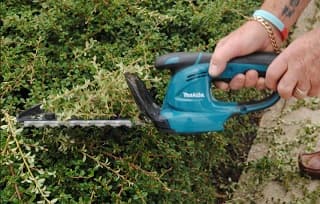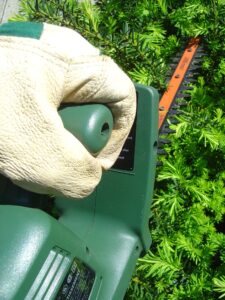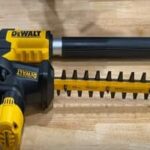As an Amazon Associate, this site earns commissions from qualifying purchases. For more information click here.
You have probably heard that the best way to get rid of weeds is to pull them off. But what if there are a lot of weeds in your garden? Pulling them individually is not practical, and this is where a hedge trimmer can prove useful. This tool is not just for hedges as it is also good for bushes and other shrubbery.
A hedge trimmer can be useful if you need to cut a large number of weeds. A gas powered hedge trimmer is more suitable than an electric model as you have greater freedom of movement.
How to Use a Hedge Trimmer to Cut Weeds
Cutting weeds is a bit different from trimming say, blackberry bushes. You do not have to worry about the shape or form. In this case you just need to start the hedge trimmer and cut as many of the weeds as you can.
This video shows you how a hedge trimmer can be used to cut weeds.
Step 1 – Safety First
Wear work gloves, sturdy shoes or steel toe boots and safety glasses. Wear ear plugs if you are going to use a gas hedge trimmer because it can get noisy. Ear protection is not necessary if you use an electric or battery hedge trimmer.
Work gloves protect your fingers from being accidentally cut by the blades. They also keep your hands from getting sore from holding the hedger for long periods.
Steel toe boots or study shoes protect your feet in case you hit a sharp object. It is also a good idea to wear thick jeans to protect your legs. If the sun is out and you need to cut a lot of weeds, bring a hat and a bottle of water.
If you are still looking for a gas hedge trimmer, the Echo Hedge Trimmer HC-155 is going to work just fine.
Step 2 – Inspect the area
Check the site and remove any objects that could get in the way. Coins, plastics, garden tools, debris etc. Hedge trimmers can get jammed if the blade hits something sharp or metallic. In other words, clean the area so the hedger will not into anything it cannot cut.
Related. How to fix a jammed hedge trimmer
Step 3 – Start cutting
Turn your hedge trimmer on. If it is battery, you just need to press a button. If it is electric, plug the unit into a power outlet. Check first if the cord is long enough for you to use. For gas models, add fuel according to the owner’s manual and turn it on.
If there are objects you cannot move- large rocks for instance – maneuver the hedge trimmer around it. Use your feet to move small rocks out of the way. These can also clog the blades so avoid those as well.
Cutting weeds is straightforward and easy with a hedge trimmer. Hold it firmly and move the blade from one side to the next. You can start left to right or right to left.
If the weeds are tall, cut it one layer at a time. Cut 1-2 inches as you sweep the blade from one end to the other. Then cut another layer and so on. Unlike hedges, you do not have to be precise here. If you see a large rock in the way, move the hedge trimmer away from it.
Step 5 Finishing Up
Once you are finished, remove any clippings stuck on the blade. Clean the area and dispose of the weeds. Repeat the process if there are additional areas you have to trim. When you are done for the day, wait for the hedge trimmer to cool down before storing it.
Tips for Using a Hedge Trimmer
Planning is essential. Weeds spread rapidly so it helps to plan ahead. If you have to work on a large area, section it into parts. This will make it easier to manage.
You should also rest once in a while. This is necessary to prevent your hands, arms and wrists from getting sore. If you are cutting short weeds, bending over for prolonged periods is going to hurt your back too. If you can get a low chair, use that to make cutting easier.

If you are using an electric hedge trimmer, make certain the cord is not entangled. You should also watch out for the cord as you might accidentally cut it.
Do not let the hedge trimmer overheat. If the engine gets too hot, turn it off and let it cool down for a few minutes. This can happen when you cut large areas and the temperature is hot. With electric hedgers you also have to watch out for the rain, as you should never use the tool in those conditions.
Which Hedge Trimmer Should You Use?
There are lots of hedge trimmers available, but they come down to three types: battery, electric and gas.
If you only need to work on a small area, an electric or battery hedger will be enough. Battery-run trimmers are the least powerful, but they are portable and easy to use. These are also quiet and can be recharged. The drawback is the limited power and runtime. Still, it is ideal for a small garden.
An electric hedge trimmer can handle more weeds. Unlike gas or battery, it has unlimited power as long as it is plugged in. But that is its shortcoming too. You can only use electrical power if the cord is long enough to reach the power source. If you need to cover a lot of ground, a corded trimmer may not be enough. A powerful cordless hedge trimmer though is the Redback 40V, so that is something you may consider.
So it comes down to what you need, as there is no one-size-fits-all solution. And it does not stop there; once you have decided to go with gas for example, you have to compare the different types to see which fits your needs.
Frequently Asked Questions
Which is better, pulling or cutting weeds?
Pulling weeds is more effective than cutting if you completely uproot the weeds. However this is not practical if you have a large garden. A better solution is to use a hedge trimmer or string trimmer to remove the weeds.
Unless you cut all the way to the ground and uproot the weeds, they will sprout back. This is why regular maintenance is essential. Do not wait for the weeds to grow tall before trimming them off again.
Which hedge trimmer blade is best for cutting weeds?
There are different blade sizes available, but your hedge trimmer may be compatible with just a few. When it comes to weeds, choose sharp blades and as wide as possible. You might come across thick branches or vines and being able to cut them will make your work easier.
Can a hedge trimmer cut wet weeds?
Wait for the weeds to dry. Weeds like all plants, get heavier when soaked in water. Wet foliage will stick to the blades and affect its operation. Moreover, electric hedge trimmers might short circuit when used on wet materials.
Why did my hedge trimmer suddenly stop?
Turn it off and examine the blades. Most likely it hit a rock or another object while cutting. While the blades are sharp, they cannot handle large and sharp objects.
How long does it take hedge trimmers to remove weeds?
It depends on how much power the tool has and how much material needs to be cut. It also depends on how fast you go. But it is better to go slowly and thoroughly. The most efficient way to cut overgrown weeds is to slice one layer at a time.
Will weeds grow again after removing them with my hedge trimmer?
Yes, the weeds will sprout again. The only way to stop weeds from growing completely is to uproot them.
Why is my hedge trimmer so hot?
This could be a sign the engine is overheating. It can happen if the hedge trimmer is underpowered or the temperature is too high. Turn the motor off and allow it to simmer down.

I love the outdoors and all the tools for maintaining gardens, yards and lawns. The only thing I am more passionate about is sharing what I know about garden and outdoor equipment.


